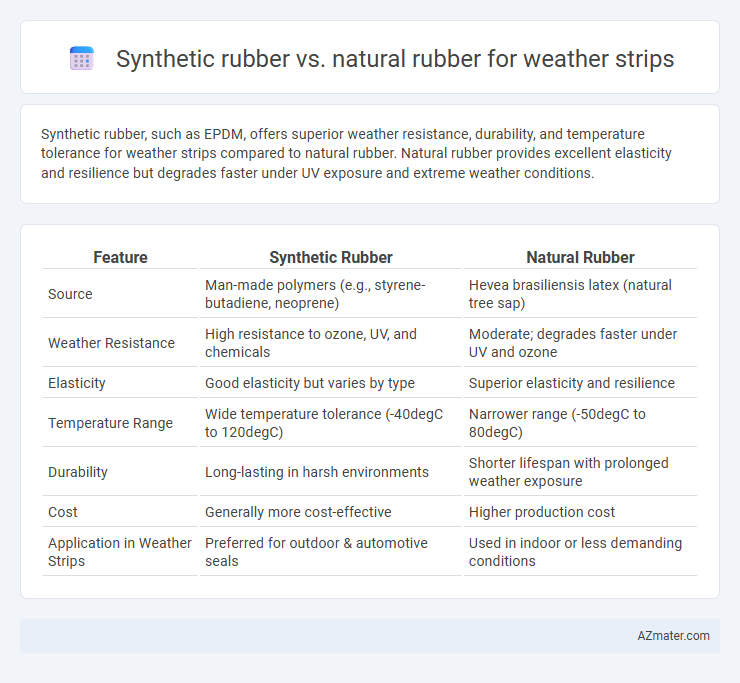Synthetic rubber, such as EPDM, offers superior weather resistance, durability, and temperature tolerance for weather strips compared to natural rubber. Natural rubber provides excellent elasticity and resilience but degrades faster under UV exposure and extreme weather conditions.
Table of Comparison
| Feature | Synthetic Rubber | Natural Rubber |
|---|---|---|
| Source | Man-made polymers (e.g., styrene-butadiene, neoprene) | Hevea brasiliensis latex (natural tree sap) |
| Weather Resistance | High resistance to ozone, UV, and chemicals | Moderate; degrades faster under UV and ozone |
| Elasticity | Good elasticity but varies by type | Superior elasticity and resilience |
| Temperature Range | Wide temperature tolerance (-40degC to 120degC) | Narrower range (-50degC to 80degC) |
| Durability | Long-lasting in harsh environments | Shorter lifespan with prolonged weather exposure |
| Cost | Generally more cost-effective | Higher production cost |
| Application in Weather Strips | Preferred for outdoor & automotive seals | Used in indoor or less demanding conditions |
Introduction to Weather Strips
Weather strips are essential components used to seal gaps in doors and windows, providing insulation against weather elements. Synthetic rubber, such as EPDM, offers superior durability, resistance to ozone, UV rays, and extreme temperatures, making it ideal for long-lasting weather strips. Natural rubber, while flexible and resilient, tends to degrade faster under harsh environmental conditions, limiting its effectiveness in weather seal applications.
What is Synthetic Rubber?
Synthetic rubber is a man-made elastomer produced through polymerization of petroleum-based monomers, offering enhanced durability and resistance to weathering compared to natural rubber. It exhibits superior protection against ozone, UV rays, and temperature variations, making it ideal for weather strip applications where prolonged exposure to harsh environmental conditions occurs. Its consistent quality and customizable properties allow manufacturers to optimize weather strips for specific performance requirements, surpassing the natural rubber's susceptibility to degradation.
What is Natural Rubber?
Natural rubber is an elastomer derived from the latex sap of rubber trees (Hevea brasiliensis), prized for its excellent elasticity, tensile strength, and resilience. Its cellular structure provides superior flexibility and cushioning, making it ideal for weather strips that require durable sealing against air and moisture infiltration. Unlike synthetic rubber, natural rubber offers enhanced environmental resistance but can be more susceptible to degradation from UV exposure and ozone without proper additives.
Key Physical Properties Comparison
Synthetic rubber offers superior resistance to ozone, UV rays, and temperature extremes compared to natural rubber, making it ideal for weather strips exposed to harsh outdoor conditions. Natural rubber exhibits excellent elasticity and tensile strength but tends to degrade faster under sunlight and oxidative environments. Key physical properties such as hardness, abrasion resistance, and flexibility vary significantly; synthetic options like EPDM provide better aging resistance and consistent performance, while natural rubber delivers superior flexibility and resilience in moderate climates.
Weather Resistance and Durability
Synthetic rubber, such as EPDM and neoprene, offers superior weather resistance compared to natural rubber, making it ideal for weather stripping exposed to harsh environmental conditions like UV rays, ozone, and extreme temperatures. Its enhanced durability ensures longer service life without cracking, hardening, or deterioration, unlike natural rubber which tends to degrade faster when exposed to moisture and sunlight. Consequently, synthetic rubber is preferred for weather stripping applications requiring consistent performance and longevity in outdoor and automotive sealing environments.
Cost-Effectiveness and Availability
Synthetic rubber offers greater cost-effectiveness and consistent availability for weather strip applications due to mass production and stable supply chains. Natural rubber typically incurs higher costs and fluctuates in availability because of reliance on agricultural factors and regional production constraints. Choosing synthetic rubber ensures budget-friendly solutions with dependable access for weather stripping needs.
Environmental Impact and Sustainability
Synthetic rubber, primarily derived from petrochemicals, has a higher environmental footprint due to fossil fuel extraction and greenhouse gas emissions during production, impacting sustainability negatively. Natural rubber, sourced from rubber tree latex, offers a more eco-friendly option with biodegradability and carbon sequestration benefits, supporting a circular economy in weather strip manufacturing. However, natural rubber's sustainability depends on responsible plantation management to prevent deforestation and biodiversity loss.
Performance in Extreme Temperatures
Synthetic rubber, such as EPDM and silicone, outperforms natural rubber in weatherstripping applications exposed to extreme temperatures, maintaining flexibility and resilience from -50degC to 150degC. Natural rubber tends to harden and crack under prolonged exposure to UV rays and temperature fluctuations, reducing its sealing effectiveness. The superior thermal stability and aging resistance of synthetic rubber ensure a longer lifespan and enhanced performance in harsh environmental conditions.
Application Suitability in Weather Stripping
Synthetic rubber offers superior resistance to temperature extremes, UV radiation, and ozone, making it highly suitable for weather stripping exposed to harsh outdoor conditions. Natural rubber provides excellent flexibility and resilience, which is advantageous for indoor weather stripping applications where exposure to environmental stressors is minimal. For optimal weather strip performance in automotive, doors, and windows, synthetic rubber variants like EPDM are preferred due to their durability and long-term sealing effectiveness.
Conclusion: Choosing the Right Rubber for Weather Strips
Synthetic rubber offers superior resistance to ozone, UV rays, and temperature extremes, making it ideal for weather strips exposed to harsh environmental conditions. Natural rubber provides excellent elasticity and tensile strength but tends to degrade faster when exposed to sunlight and harsh weather. Selecting the right rubber for weather strips depends on the specific application requirements, with synthetic variants like EPDM or neoprene preferred for durability and natural rubber suited for less demanding environments.

Infographic: Synthetic rubber vs Natural rubber for Weather strip
 azmater.com
azmater.com